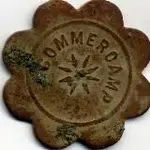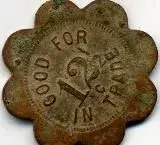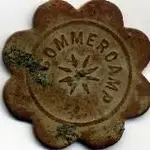This token is definitely brass. Tokens of this era were seldom made in copper. Manufacturers usually used whatever alloy of copper and zinc that was in the melt pot, so there is a variety of appearances of the brass - from yellow to copper color.
Valuations for tokens depend on supply and demand. Published rarity figures for trade tokens are to be taken with a grain of salt since the collecting of them is a relatively new hobby and the existing supply of each token has not been accurately established. Civil War tokens, on the other hand and for example, have been widely collected since they were first used, and the population of each variety is fairly well known. Coins in general have even better population figures and corresponding published valuations. This is because the number minted is often known. Few records are extant for the number of trade tokens known so even the starting number is seldom known. When businesses closed, trade tokens became worthless and were usually destroyed or otherwise disposed of.
Your token is a "maverick" - the business that used it chose not to indicate the town and state where it was from. Subsequent research has not proven a location, although there are theories as to the attribution. That detracts from the value in the eyes of most collectors.
So, what is it worth? Until you willingly sell it to a willing buyer, you may never know. If you want a general idea, you can check eBay to see what similar unattributed mavericks sell for. Of course you will have to wade through a lot of tokens to pick out the mavericks, and then you will have to evaluate whether they are similar enough to yours to be considered as a "comparable". This is like the real estate people who put a value on your house based on "comps" made up of houses that have recently sold in your area - there are seldom two houses exactly alike.
As a shortcut to the above, I've purchased or know of purchases of tokens comparable to this one over the past few years for anywhere from $1 to $25 or so.
John in ID







